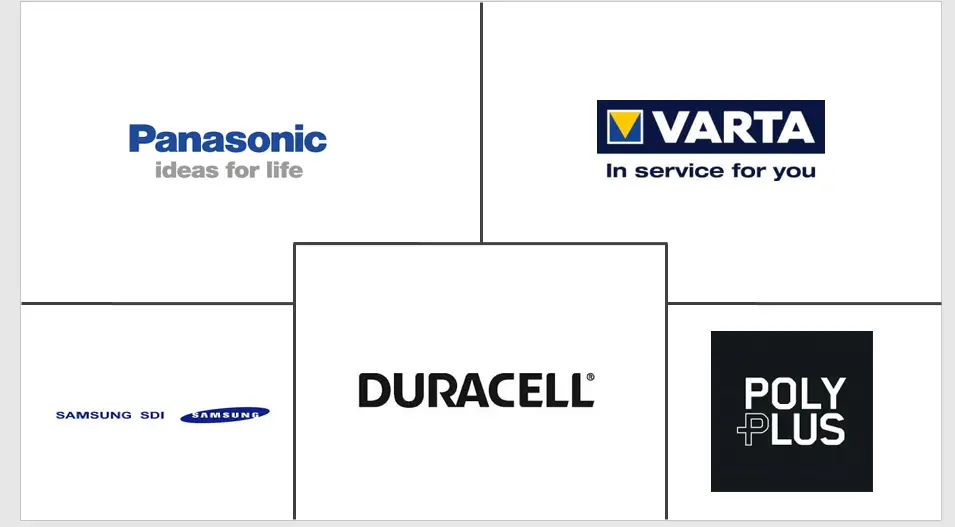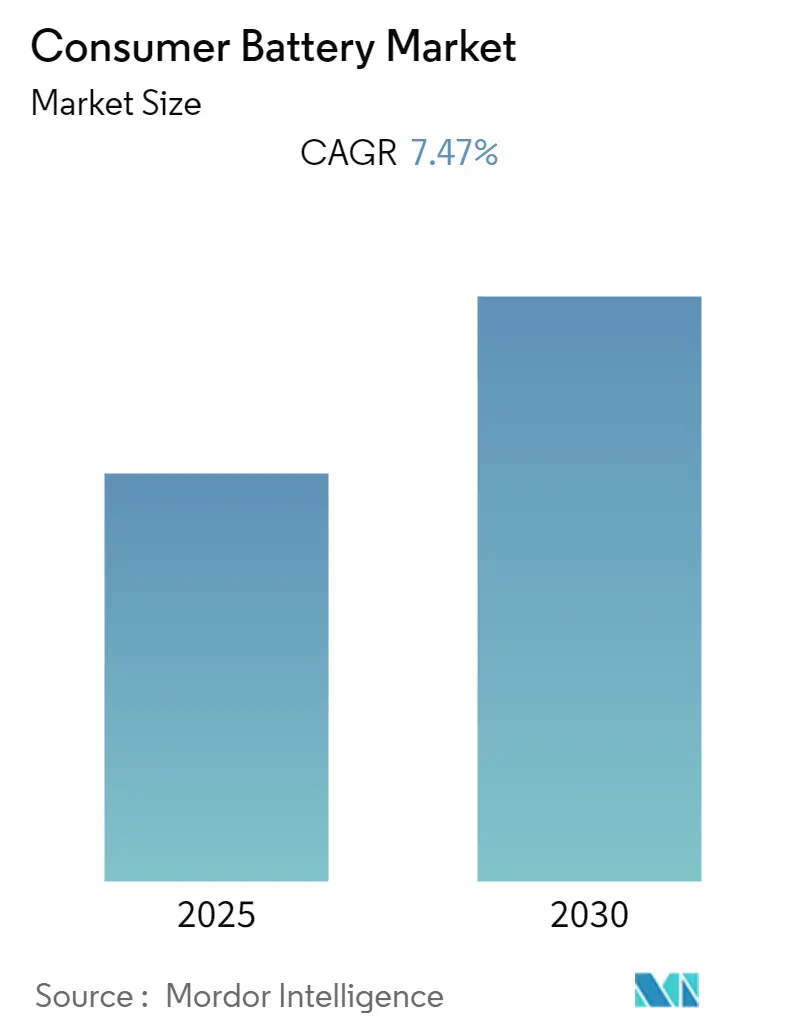
Consumer Battery Market Analysis by Mordor Intelligence
The Consumer Battery Market is expected to register a CAGR of 7.47% during the forecast period.
- Over the medium term, the increasing demand for portable electronics items like smartphones, tablets, and wearables is expected to drive the market during the forecasted period.
- On the other hand, the limited lifespan of consumer batteries, especially rechargeable batteries, is expected to hinder the growth of the market during the forecasted period.
- Nevertheless, the increasing adaption of renewable energy sources and energy storage systems is expected to create huge opportunities for the Consumer Battery Market.
- Asia-Pacific is expected to be a dominant region for the Consumer Battery Market due to the presence of a large battery manufacturing infrastructure in the region.
Global Consumer Battery Market Trends and Insights
The Lithium-ion Batteries Segment is Expected to Dominate the Market
- Lithium-ion batteries are rechargeable batteries that use lithium ions to store and release electrical energy. They are widely used in various applications, including consumer electronics, electric vehicles, energy storage systems, etc.
- Lithium-ion batteries offer higher energy density compared to other battery chemistries. This means they can store more energy in a smaller, lighter package, making them ideal for portable electronic devices requiring long-lasting power in a compact form factor.
- Lithium-ion batteries typically have a longer lifespan than other rechargeable batteries, such as nickel-metal hydride (NiMH) or nickel-cadmium (NiCd) batteries. They can withstand more charge-discharge cycles before experiencing significant capacity loss, providing consumers with more usage time and value for their investment.
- Global lithium-ion battery manufacturers are focusing on reducing the cost of Lithium-ion batteries. The price of lithium-ion batteries declined steeply over the past ten years. In 2022, an average lithium-ion battery was valued at around USD 151 per kWh. It witnessed a decrease in the price of more than 79% in 2022 compared to 2013.
- Further, most smartphone companies, including Samsung, iPhone, Infinix, and Nokia use lithium-ion batteries. The increasing use of smartphones will drive the market for lithium-ion batteries. According to Ericsson, China, India, and the United States have the highest number of smartphone mobile network subscribers worldwide, with almost 6.6 billion in 2022, and is expected to surpass 7.8 billion in next five years.
- Additionally, in February 2022, Berkshire Hathaway Energy Renewables (BHE Renewables) announced its plans to break ground by mid-2022 on a California facility to test the commercial viability of a process that extracts lithium from geothermal brine. Once the test succeeds, the company will likely start commercializing lithium hydroxide and lithium carbonate in next three years. Such moves will likely boost the lithium-ion battery market for ESS applications in North America.
- Therefore, as mentioned above, the lithium-ion segment is expected to dominate the market during the forecasted period.
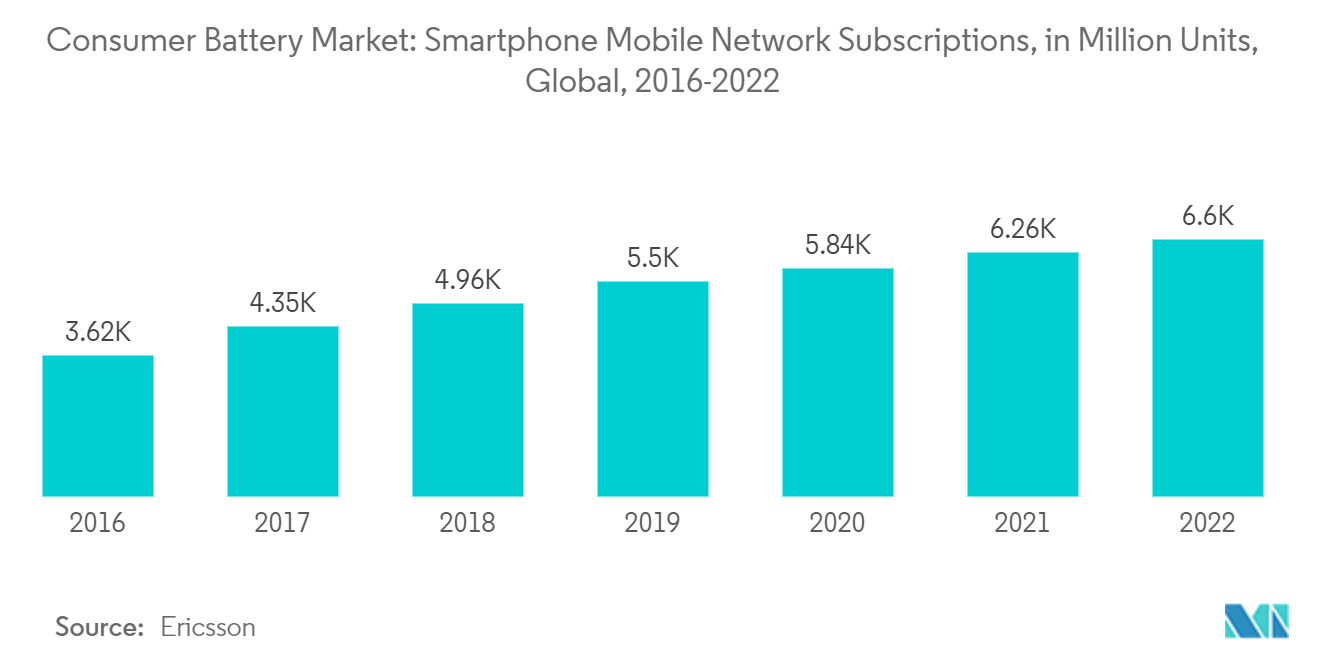
Asia-Pacific is Expected to Dominate the Market
- The Asia-Pacific region, particularly countries like China, Japan, South Korea, and Taiwan, has established itself as a manufacturing hub for consumer electronics and batteries. These countries have well-developed supply chains, production facilities, and expertise in battery manufacturing, enabling them to meet the global demand for consumer batteries.
- Moreover, Asia-Pacific is home to a significant portion of the world's population, including emerging economies with growing middle-class populations. The increasing disposable income and rising adoption of consumer electronic devices in this region drive the demand for batteries, making it a lucrative market for battery manufacturers.
- For instance, in February 2023, the Malaysian government identified the electronics market as a potential market that can become significant to the country's economy. To promote manufacturing in the electronics segment, the government announced its decision to extend the tax incentive given to manufacturing companies that relocate to Malaysia and the tax rate of 15% for C-Suite until next year.
- The Asia-Pacific region is also a major hub for the electric vehicle (EV) industry. As EVs rely heavily on lithium-ion batteries, the growing adoption of electric vehicles in countries like China, Japan, and South Korea contributes significantly to the demand for lithium-ion batteries, strengthening the region's dominance in the market.
- The Asia-Pacific region has also witnessed substantial growth in e-commerce platforms and online retail. This has made consumer batteries easily accessible to a wide customer base, contributing to the market's expansion. E-commerce provides convenience, competitive pricing, and a vast range of options for consumers to purchase batteries, fueling the market's dominance.
- Therefore, per the points mentioned above, the Asia-Pacific region is expected to dominate the consumer battery market during the forecasted period.
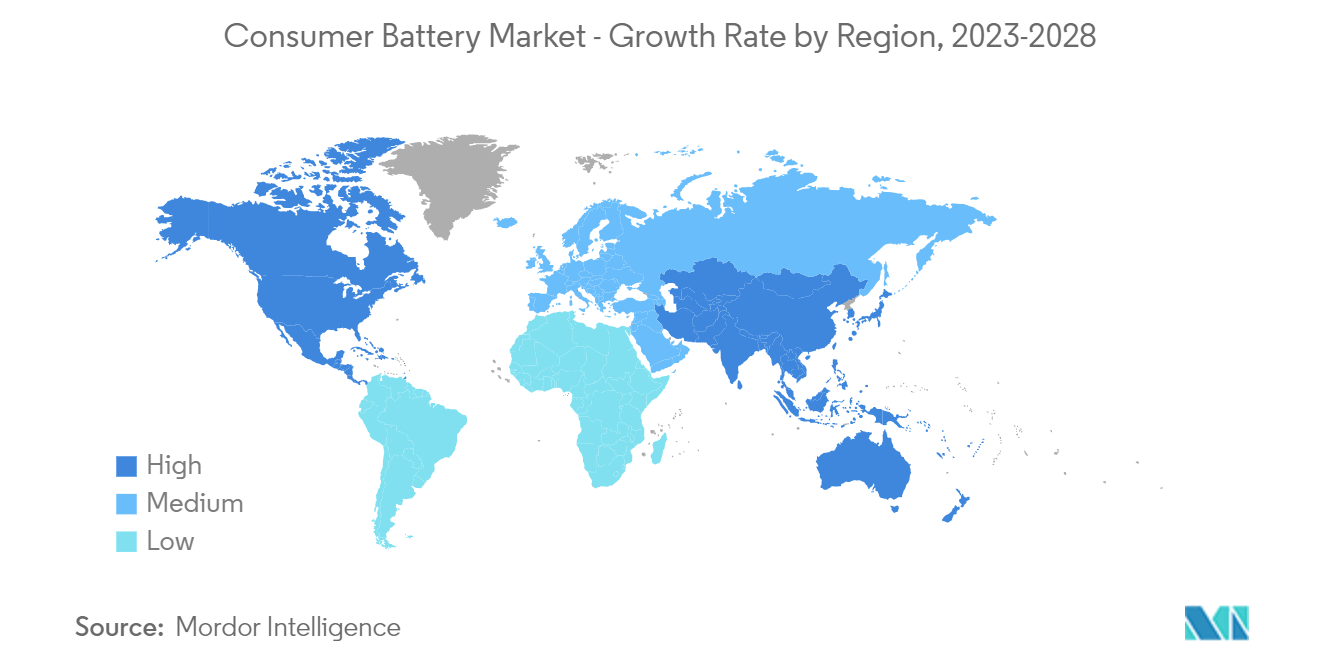
Competitive Landscape
The consumer battery market is fragmented. Some of the major companies (in no particular order) include Panasonic Corporation, VARTA Consumer Batteries GmbH & Co. KGaA, Samsung SDI Co. Ltd, Duracell Inc., and PolyPlus Battery Company Inc., among others.
Consumer Battery Industry Leaders
-
Panasonic Corporation
-
VARTA Consumer Batteries GmbH & Co. KGaA
-
Samsung SDI Co. Ltd
-
Duracell Inc.
-
PolyPlus Battery Company Inc.
- *Disclaimer: Major Players sorted in no particular order
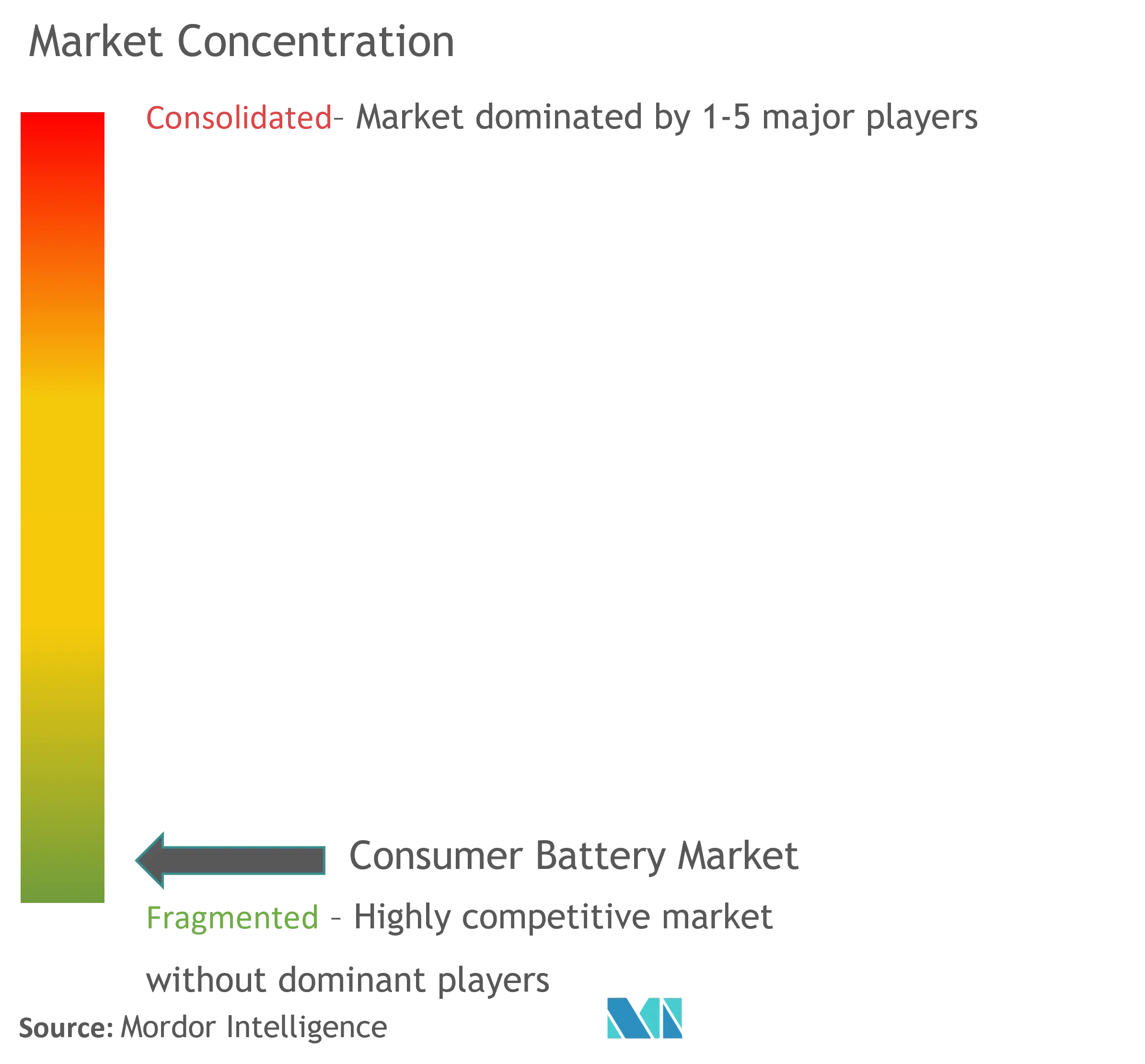
Recent Industry Developments
- June 2023: Toyota has announced its plans to incorporate high-performance solid-state batteries and other cutting-edge technologies into upcoming electric vehicles (EVs) to enhance the driving range and reduce costs. This technology roadmap unveiled by the Japanese automaker encompasses many initiatives, including developing next-generation batteries and a radical redesign of manufacturing facilities. This comprehensive disclosure represents Toyota's determined strategy to compete in the rapidly expanding EV market.
- April 2023: Volkswagen is strengthening its collaboration with Redwood Materials by introducing a consumer battery recycling program. Volkswagen of America, Inc. and Redwood Materials, Inc. will provide consumers with a convenient solution to recycle their rechargeable devices and lithium-ion batteries. Participating Volkswagen dealerships will offer Redwood bins to facilitate this initiative, allowing for safe and hassle-free drop-off of rechargeable batteries and consumer devices such as cell phones, laptops, tablets, cordless power tools, electric toothbrushes, wireless headphones, and old vacuum batteries.
Global Consumer Battery Market Report Scope
Consumer batteries are portable power sources designed for consumer electronic devices. They are compact, lightweight and often come in standardized sizes and formats to fit various consumer devices, such as smartphones, laptops, cameras, remote controls, toys, and other portable electronics. Consumer batteries are typically categorized into two main types: disposable (primary) batteries and rechargeable (secondary) batteries.
The Consumer Battery Market is segmented by technology type and geography. By technology type, the market is segmented into lithium-ion batteries, zinc-carbon batteries, alkaline batteries, nickel metal hydride, nickel cadmium, and other types. The report also covers the market size and forecasts for the consumer battery market across major regions such as North America, Europe, Asia-Pacific, South America and Middle-East & Africa. For each segment, the market sizing and forecasts have been done based on revenue (USD million).
| Lithium-ion Batteries |
| Zinc-carbon batteries |
| Alkaline Batteries |
| Nickel Metal Hydride |
| Nickel Cadmium |
| Other Types |
| North America | United States |
| Canada | |
| Rest of North America | |
| Asia-Pacific | India |
| China | |
| Japan | |
| Australia | |
| South Korea | |
| Rest of Asia-Pacific | |
| Europe | Germany |
| United Kingdom | |
| Italy | |
| France | |
| Spain | |
| Rest of Europe | |
| South America | Brazil |
| Argentina | |
| Chile | |
| Rest of South America | |
| Middle-East and Africa | Saudi Arabia |
| United Arab Emirates | |
| South Africa | |
| Qatar | |
| Rest of Middle-East and Africa |
| Type | Lithium-ion Batteries | |
| Zinc-carbon batteries | ||
| Alkaline Batteries | ||
| Nickel Metal Hydride | ||
| Nickel Cadmium | ||
| Other Types | ||
| Geography Regional Market Analysis {Market Size and Demand Forecast till 2028 (for regions only)} | North America | United States |
| Canada | ||
| Rest of North America | ||
| Asia-Pacific | India | |
| China | ||
| Japan | ||
| Australia | ||
| South Korea | ||
| Rest of Asia-Pacific | ||
| Europe | Germany | |
| United Kingdom | ||
| Italy | ||
| France | ||
| Spain | ||
| Rest of Europe | ||
| South America | Brazil | |
| Argentina | ||
| Chile | ||
| Rest of South America | ||
| Middle-East and Africa | Saudi Arabia | |
| United Arab Emirates | ||
| South Africa | ||
| Qatar | ||
| Rest of Middle-East and Africa | ||
Key Questions Answered in the Report
What is the current Consumer Battery Market size?
The Consumer Battery Market is projected to register a CAGR of 7.47% during the forecast period (2025-2030)
Who are the key players in Consumer Battery Market?
Panasonic Corporation, VARTA Consumer Batteries GmbH & Co. KGaA, Samsung SDI Co. Ltd, Duracell Inc. and PolyPlus Battery Company Inc. are the major companies operating in the Consumer Battery Market.
Which is the fastest growing region in Consumer Battery Market?
Asia Pacific is estimated to grow at the highest CAGR over the forecast period (2025-2030).
Which region has the biggest share in Consumer Battery Market?
In 2025, the Asia Pacific accounts for the largest market share in Consumer Battery Market.
What years does this Consumer Battery Market cover?
The report covers the Consumer Battery Market historical market size for years: 2020, 2021, 2022, 2023 and 2024. The report also forecasts the Consumer Battery Market size for years: 2025, 2026, 2027, 2028, 2029 and 2030.
Page last updated on:
Consumer Battery Market Report
Statistics for the 2025 Consumer Battery market share, size and revenue growth rate, created by Mordor Intelligence™ Industry Reports. Consumer Battery analysis includes a market forecast outlook for 2025 to 2030 and historical overview. Get a sample of this industry analysis as a free report PDF download.
